Every bike in the MSI's bike exhibit from 2013
When we heard that there was a bike exhibit at the MSI, of course we had to hunt it down. When I got there, I realized that I could photograph and list out every bike in the exhibit, which would itself be an instructive survey of what was "interesting in the world of bikes" when this exhibit was built - obviously, from the production dates of the newest bikes, 2013 exactly.
The curators' snapshot of the bike industry in 2013 is a frustrating and fascinating one. Almost every bike description printed in the exhibit is straight-up press release text - totally self-promoting stuff from the people who made them, to the point where several contain what I would consider falsehoods. I understand that it is always difficult to make a call about what "the cutting edge" of any technology might be, but they let people trick them, basically. It's pretty embarrassing, because some of the questions they gestured at - what is an eco-friendly bike? what makes a good bike for people in need? - could have been addressed in a much better way if they'd just selected a different bike to show for that theme.
It also contains a pair of very strange, design-forward ebikes - neither of which is even remotely like the ebikes which are now standard and affordable today. Modern ebikes come in 4 or 5 major product categories which usually feel like they are growing more and more standarized year over year, rather than more diverse. Battery form factors are also more standardized than this exhibit depicted, and more and more people have had the experience of converting a regular bicycle to an ebike using a Bafang conversion kit or similar. If I were making a modern exhibit about bicycle technology, I'd have a whole section of the exhibit about hub and mid-drive ebike technologies, and about conversion kits and homemade ebikes in particular.
The exhibit also includes some concept bikes which are presented as if they could be the future of bikes generally (they were not) - and a literal clown bike which the museum curators mistook for a general-purpose bicycle that normal people might choose to ride because it is "simple". This was insanely funny to me.
Anyway, here are the bikes! I did not include my photos of all of them because then this post would be way too image-heavy. Where the bike was easy to link to in an online database, I just did that instead.
Cervelo P5 - 2013
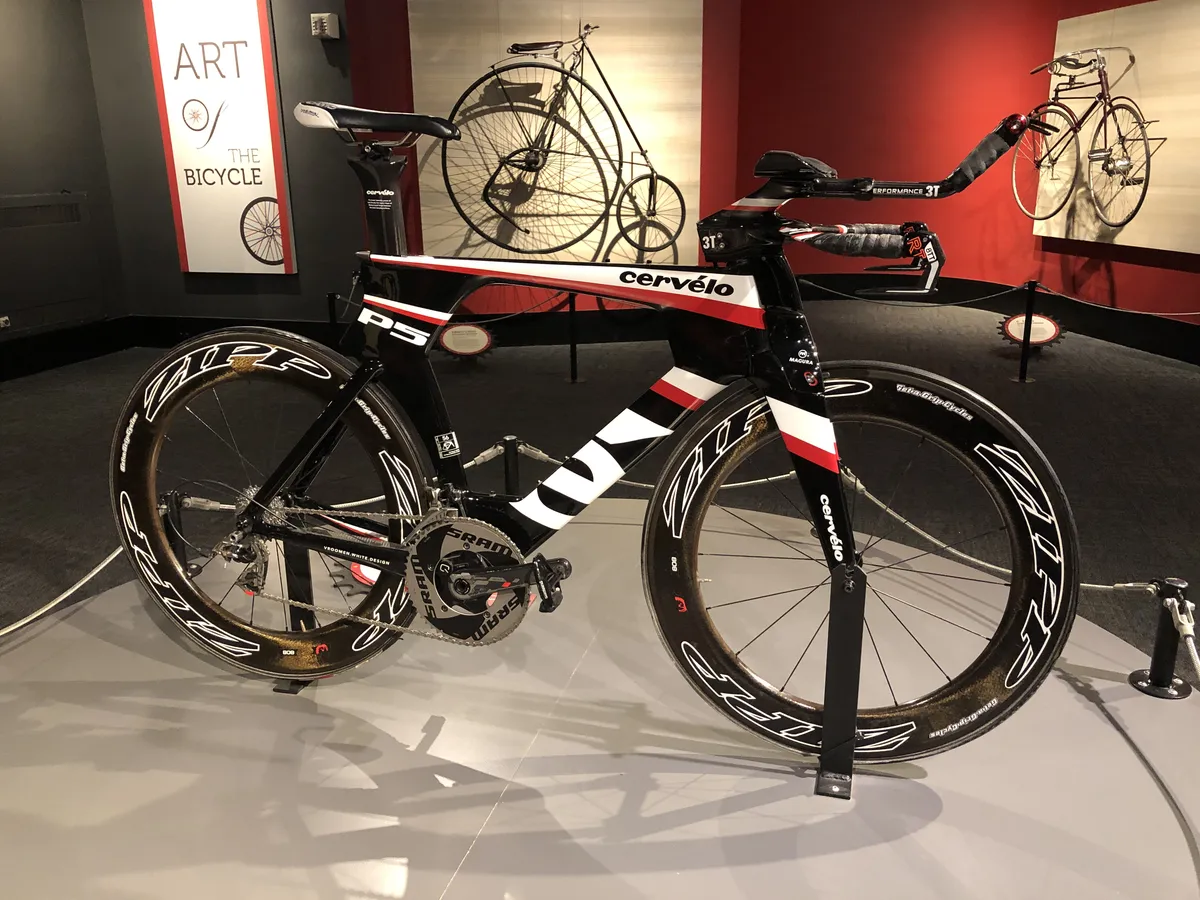
A modern Cervelo P5 sells for over 10k. It's a high-end carbon road bike - a "dentist bike," for many posters online. The site I normally use to look up old bikes doesn't have any P5s in its database before 2017, but you can see the newer ones here. All the product photos for the 2024 version of this bike come with specially shaped water bottles and shit. This was the bike right at the front of the MSI exhibit - the first thing you see upon walking in. The description says, "Engineers tested the P5 in wind tunnels and used state-of-the-art Formula 1-level Computational Fluid Dynamics Software to create a super fast bike." Very much in line with general MSI vibes throughout the museum.
Draisiene Walking Machine replica - 1818/1931
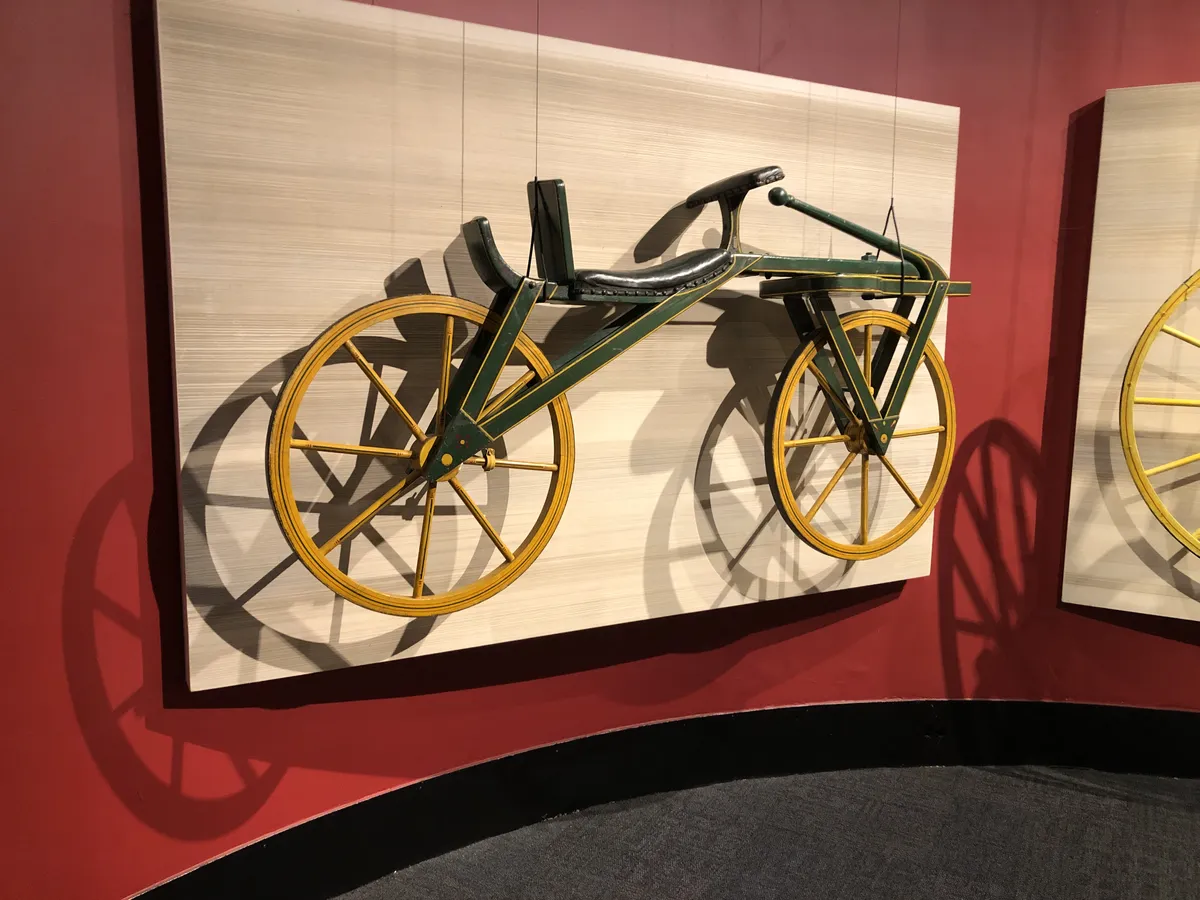
This replica was plenty old enough to be impressive to me. I talked about walking machines in this post, and in a talk I gave to Glitch City this year. The history of the bike-before-chain-drivetrains is fascinating and very weird and cool - it's wild how much the riders of ages past put up with, haha.
Riding this machine was probably super fucking uncomfortable, but it was the best thing they had at the time. This was the first step on the road to the bicycle!
The McMillan replica - 1839/1931
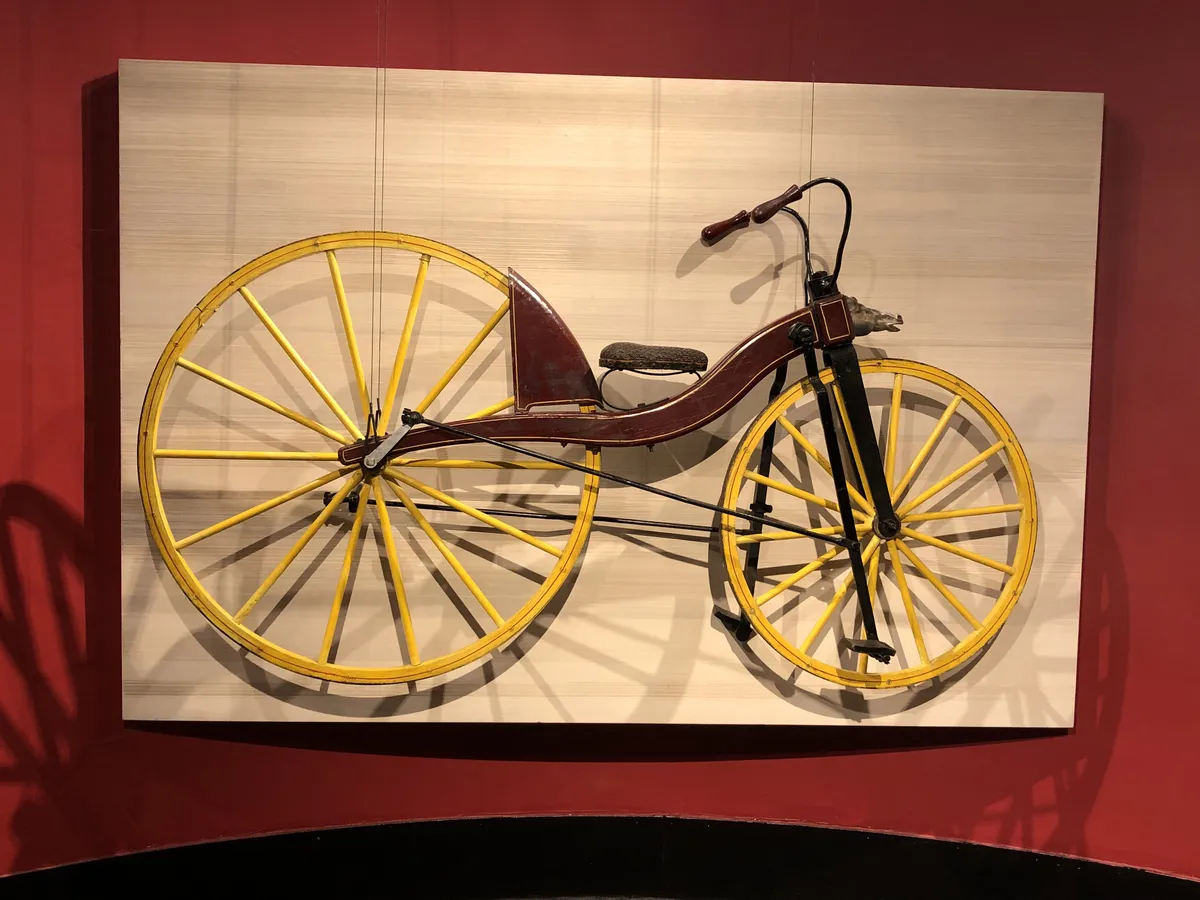
Another replica. But a cool one! I love the little metal horse face on the front. This bike has pedals, but they do not move in a circle - they shuffle awkwardly back and forth at the front of the bike in order to power the wheel at the back. This was the first walking machine with pedals.
Velocipede - 1860
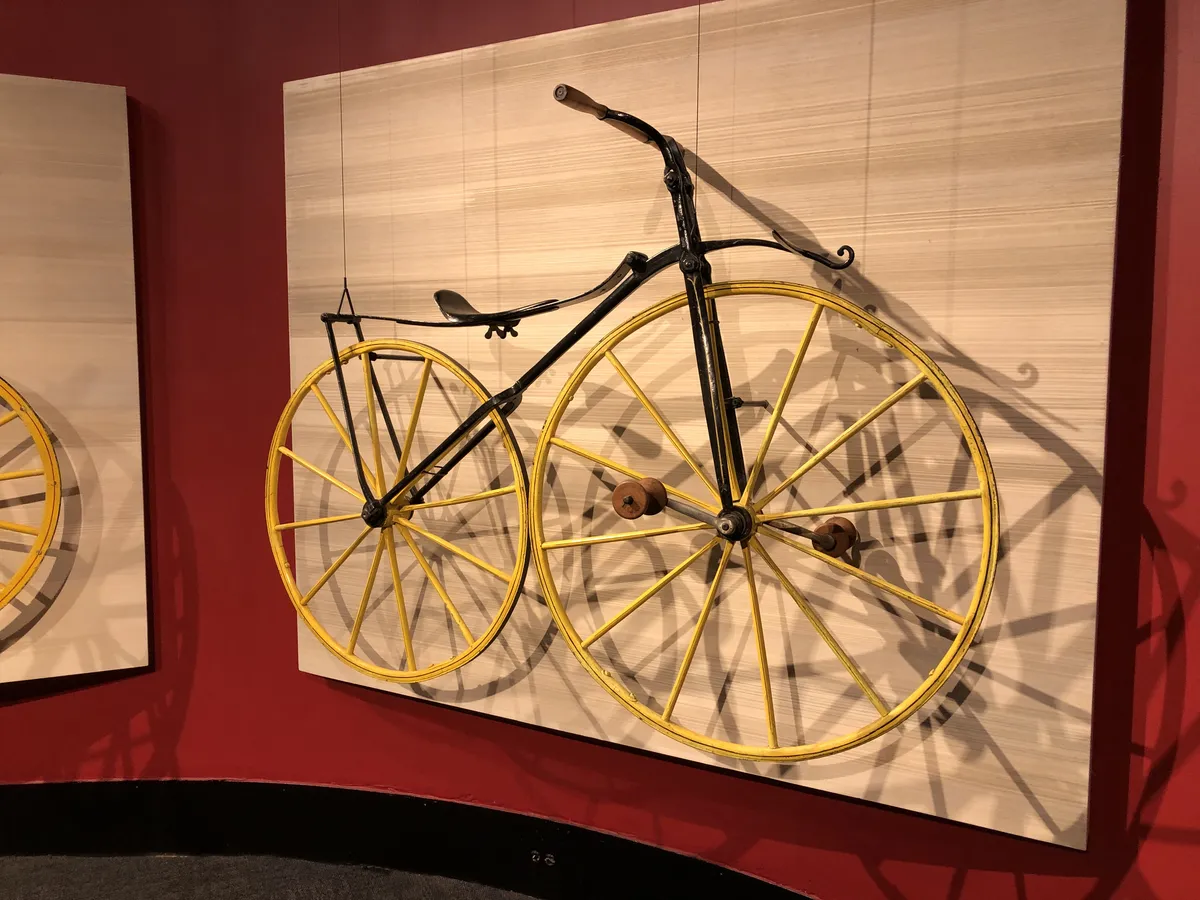
This is the real deal - not a replica! When people joke about old bikes being called "boneshakers," they are specifically talking about this exact model. You'll notice that its suspension is pretty terrible, and that the rider's posture, with feet stretching forward to turn pedals at the front wheel - is pretty bizarre. Also - the first bike here with a flatbar setup!
American Star High Wheel - 1880/1890
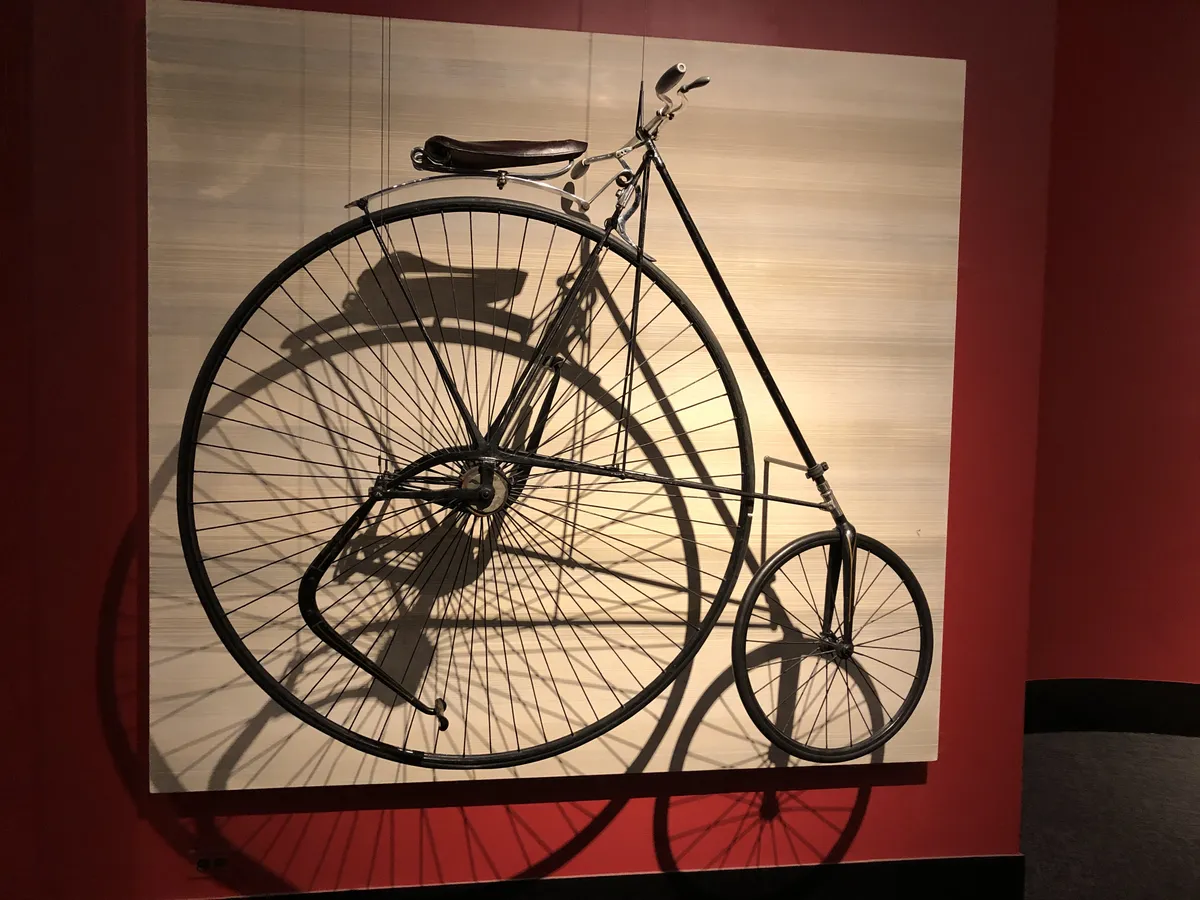
This is not a penny-farthing - it's a bike with a small wheel in the front and a giant one in the back, under the seat. Pretty weird/cool. There is some effort here to soften the ride by putting some suspension under the seat, too.
Safety Bicycle - manufacturer unknown - 1890
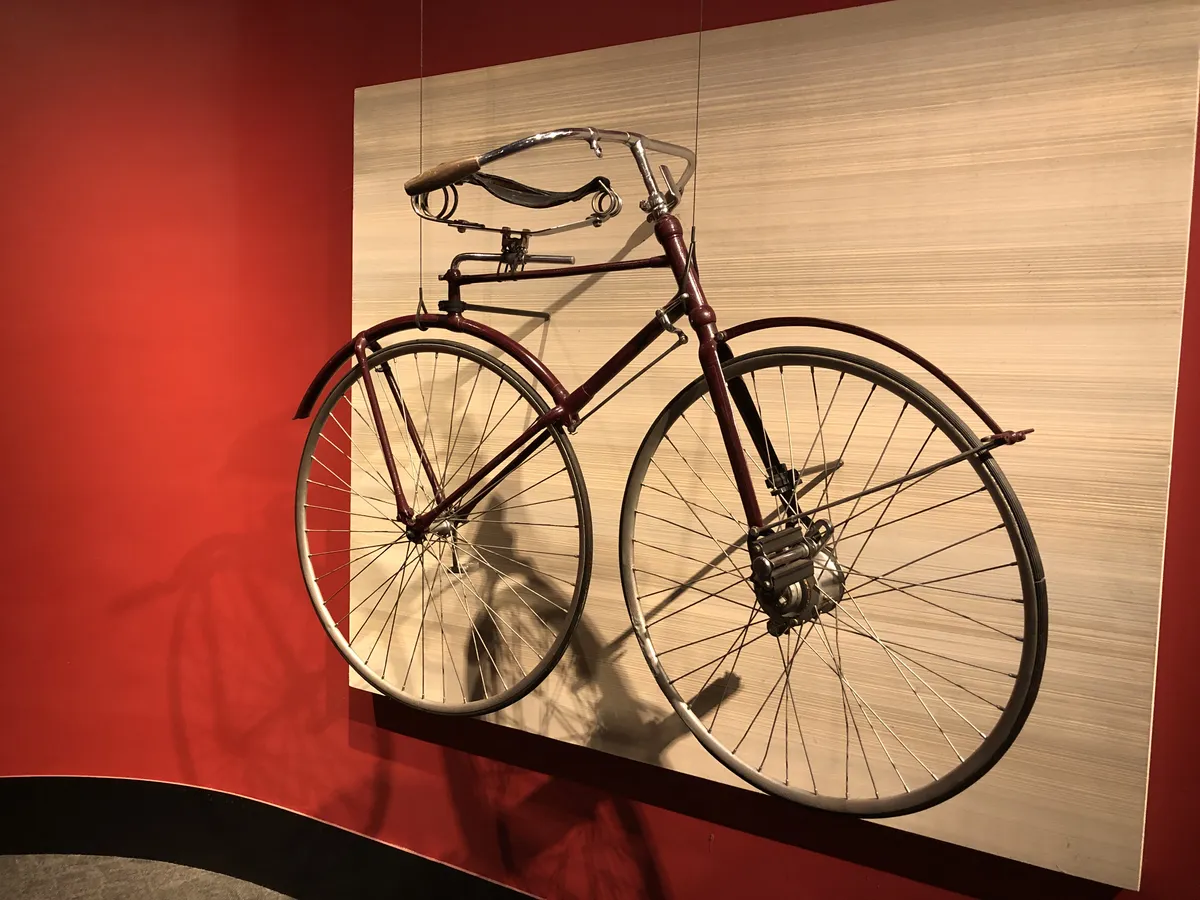
This is "the first real bicycle," some people say - it has a double-triangle frame (kind of) and a hammock seat that would have made riding it a lot easier. The pedals are still attached to the front wheel hub. It was mass-produced. They apparently do not know who built the specific machine in the MSI, which is pretty cool. Mystery bike!
Lozier & Yost Giant No. 4 Safety Bike - 1890/1900
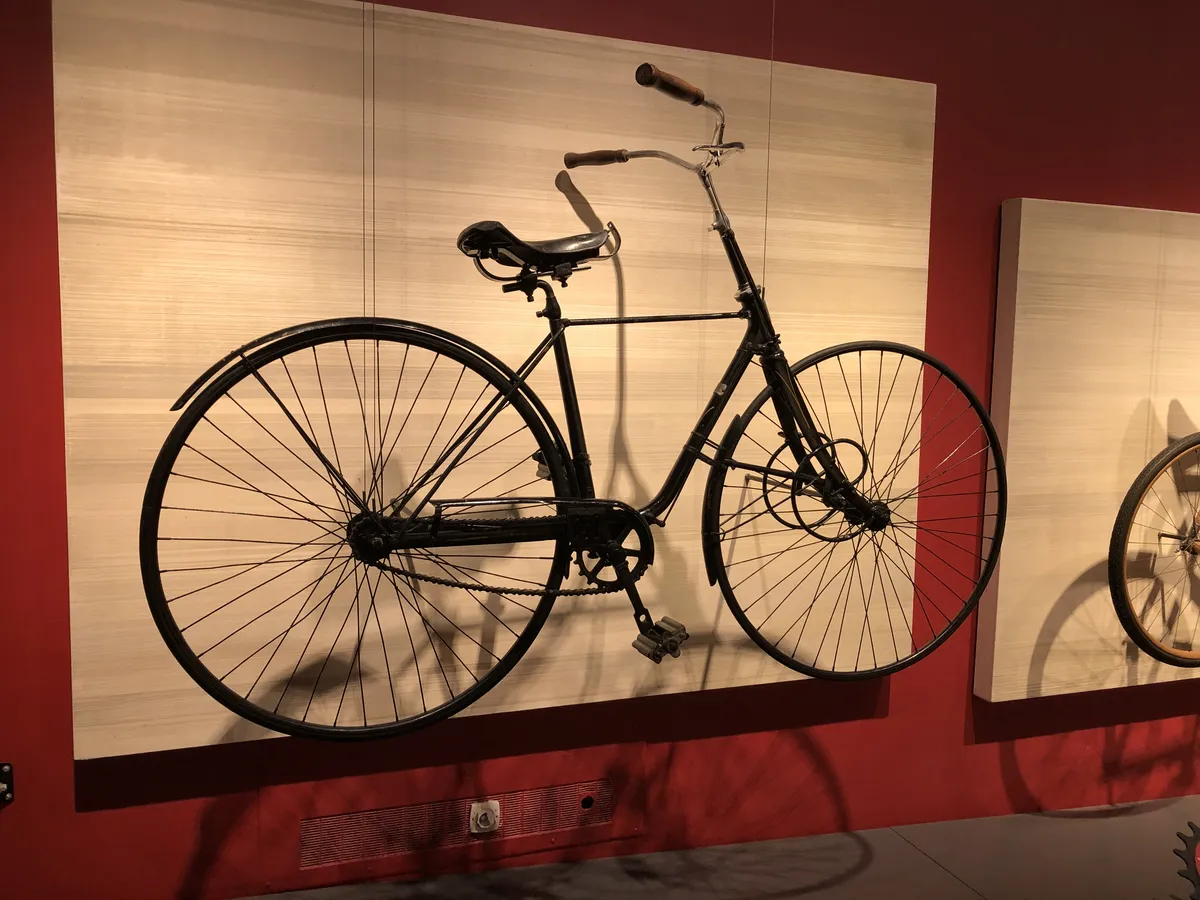
This is the first bike in the exhibit where you'd look at it and say, yep, that's basically what a bicycle is. A chain-based drivetrain, a chain guard, a double-triangle frame where both triangles are actually triangles, etc. That train is really honkin' hefty, by the way. And check out the front fork - it has a bizarre spring in it which actually looks really nice and classy. Also check out the brake - it's hard to see from the angle I took the photo, but the brake lever is fucking gigantic, like almost a foot long, haha. It pivots pretty close to the stem and operates a vertical shaft which applies the brakes.
This is the first bike in the exhibit that I feel like I could safely ride without dying!!
Safety Bicycle - Huseby Company - 1910
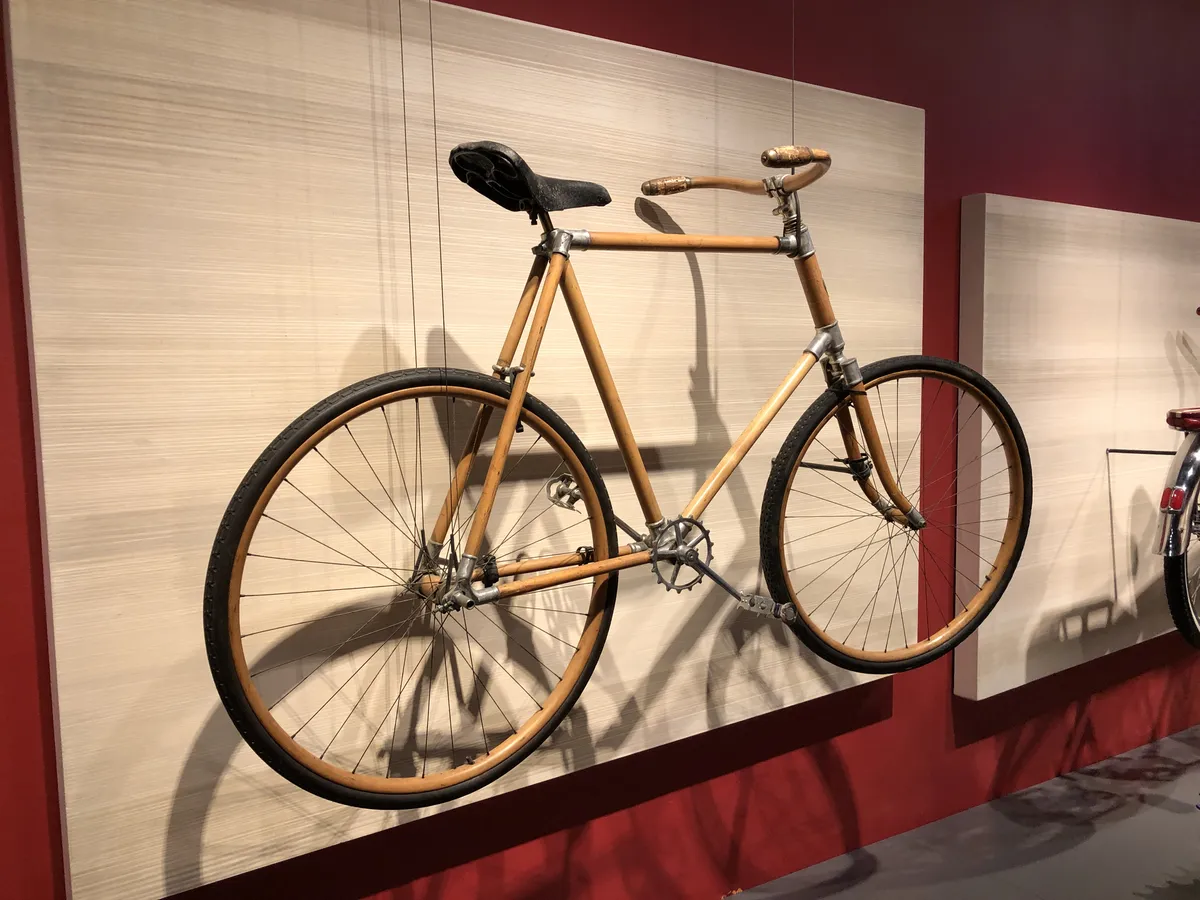
This is the first bike in the exhibit which had air-filled rubber tires. It's also made of wood, held together with metal lugs! Pretty neat. I have thought of getting myself a bamboo bike someday, which is pretty similar.
Columbia - 1955
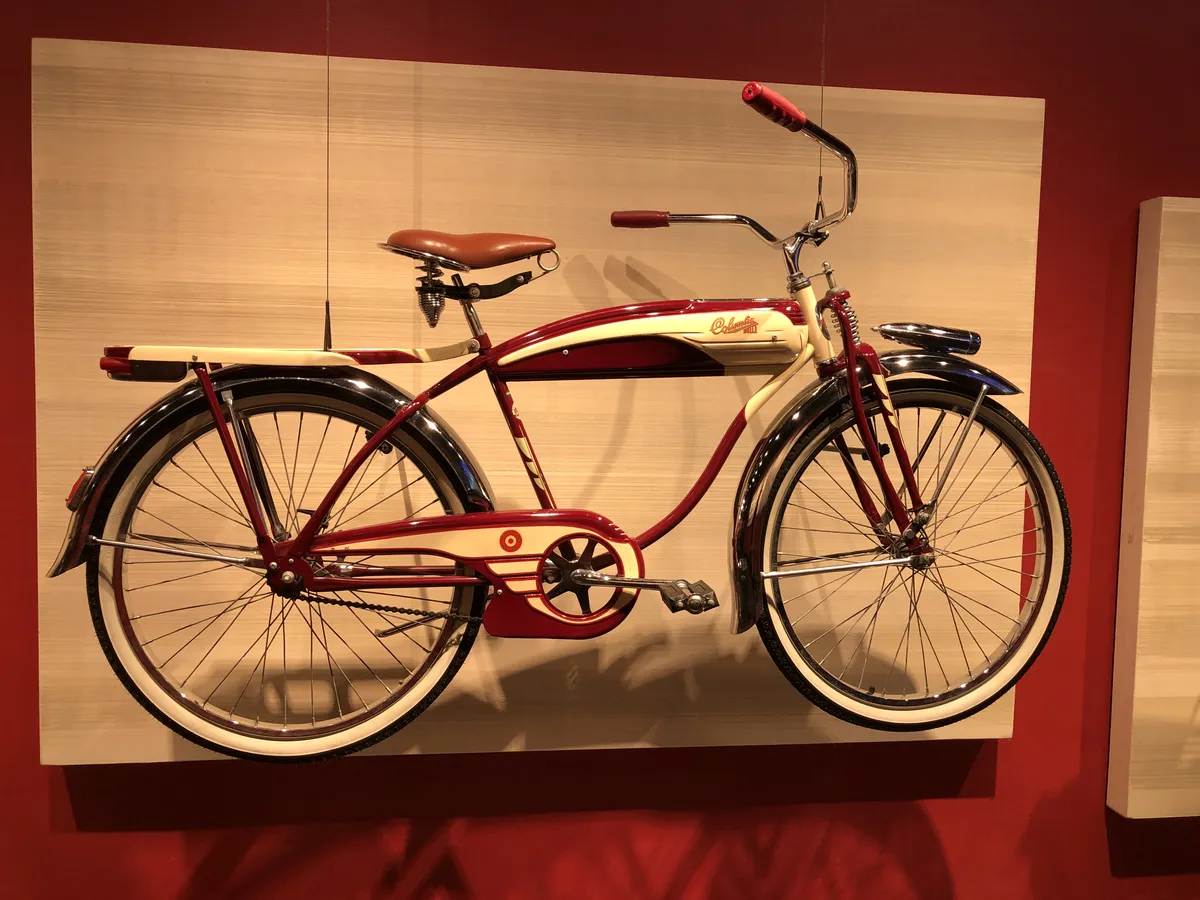
We leap from "historical" to "vintage" bikes in one big jump! You can go on eBay right now and buy a (much more normal-looking) Columbia-brand bike for under 200 USD. The model in the exhibit was a very classic one, with an enormously large and heavy frame. It does look space-age, though! At the time this bike was manufactured, Columbia also made much less fancy bikes with geometry similar to a bike you could buy new today.
Sears Spaceliner - 1965
Pictures on Flickr here! You can check out a fanatic's full list of Spaceliner models here.
Another space age bike, with a much smaller metal fairing at the front of the frame. This is getting pretty similar to a modern beach cruiser.
Schwinn "Apple Krate" Sting-Ray - probably 90s
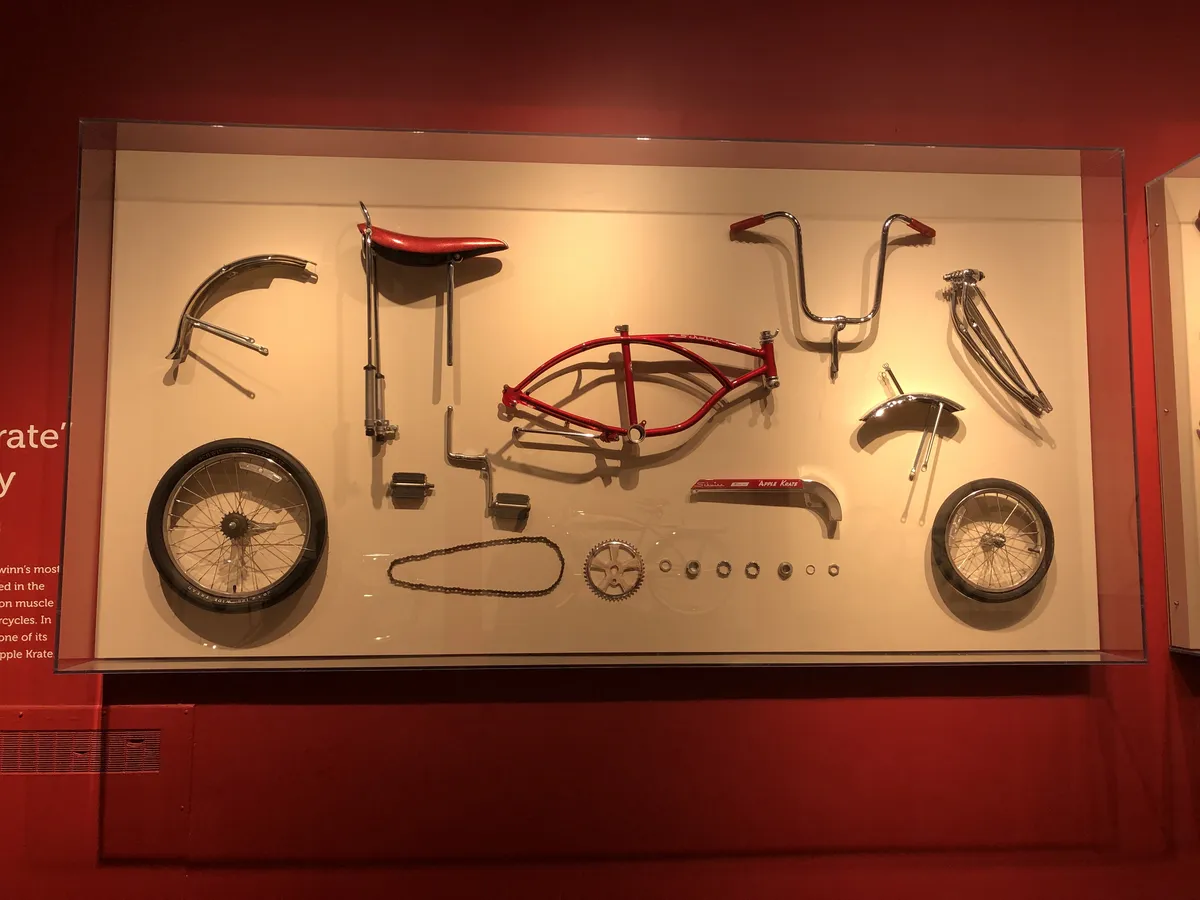
It's not entirely clear, but the text in the exhibit suggested that this was a 1990s re-release of the 1960s Sting-Ray model. I frequently see people posting these Sting-Rays online, and I'm pretty sure almost all of them are 90s versions. The bike is still for sale with all the old features - banana seat, high handlebars, "mullet" wheels with a bigger wheel in the back, etc. You can see a series of old Schwinn bike ads with 60s magazine photos of the Sting Ray model line here.
I'm not entirely sure why the MSI decided to present this one as a parts teardown - maybe for space? They were running out of hallway width here. They took apart the bottom bracket but didn't take apart the headset, hubs, etc, so it's a bit misleading on the "what parts are in a bike" front.
Co-Motion Periscope Trident - 2012
Yes, this is a three-person tandem bike. Check out the manufacturer's website here. These bikes are custom-fit to the owners. The prices start at $6895 - insert tech-worker-polycule joke here. (That's a cheap shot, though - it's actually a lot more likely that the people buying this would be doing it to drag kids along on a long ride.)
PiMobility Electric Hybrid - 2013
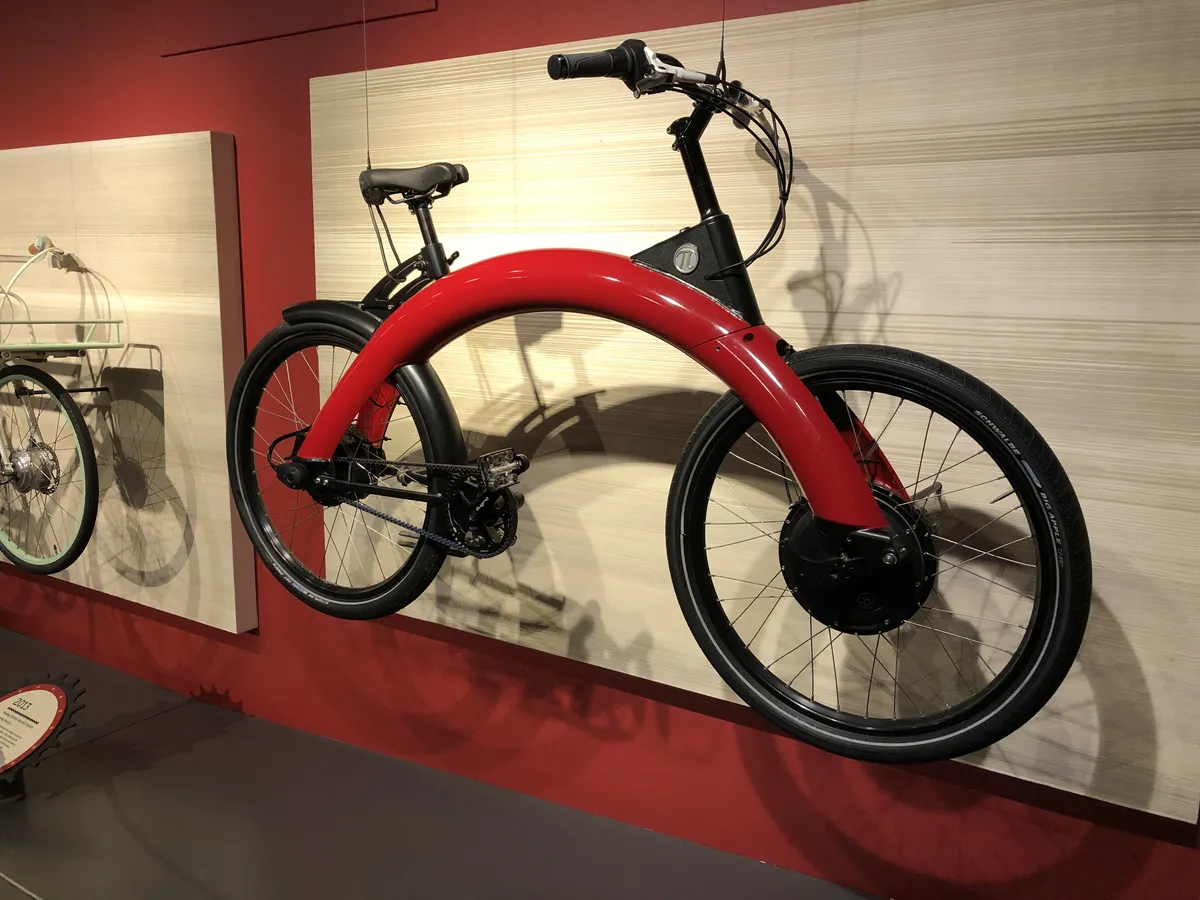
I can't link to this bike in a bike database site because it's just old enough that most non-press-release info about it was completely obliterated by its manufacturer's collapse. It looks cool, but it's preposterous to think that the industry and riders would have preferred to buy something like this instead of ebikes utilizing industry-standard parts and frame designs.
You can tell that they designed the frame this way to get the carbon belt drive on there without having to design a belt-compatible frame. If you put a belt drive on a regular bike, you need to create a joint in the rear triangle - unlike a chain, carbon belt drives cannot be split and rejoined to get around the tubing in the rear triangle.
But the PiCycle's solution to this problem is ridiculous. People today... just put a splittable rear triangle on the goddamn bike... it's not so stupid!! Makes a lot more sense than this!!!
It's funny - the museum description of this bike is also horribly incorrect and out-of-date. It reads: "Its unique arch design, which replaces the bicycle's standard diamond frame, is a key structural element that stores and cools the bicycle's lithium battery." Dipshits: you can just attach the battery to a regular bike frame, or design a regular double-triangle frame that contains the battery. You do not need to design an arch to hold the battery, nor lie about why the arch is there. The arch is there for the belt drive, numbskull. Makes me wonder what other elements in the museum are as direly out-of-date and straight-up wrong as this bike description is. MSI curators: please, just go outside, look at some ebikes on the street, and rewrite this thing!! Or, better yet, stop filling your museum entirely with products you obtained as marketing materials from startups!!!
Faraday Porteur Electric Hybrid - 2013
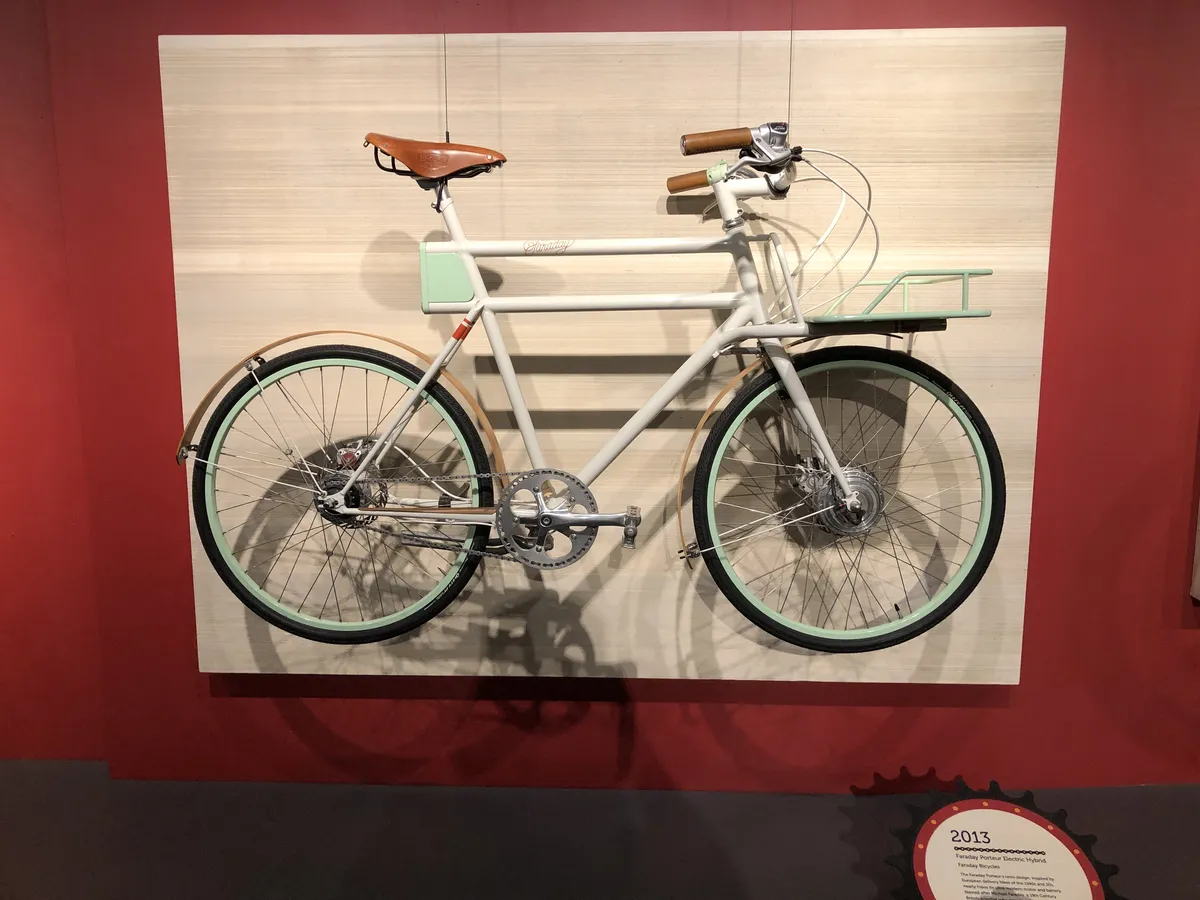
It's very funny to me that both of the ebikes they selected for this exhibit are very design-forward bikes with unusual form factors. The industry has now abandoned these frame shapes. Faraday shut down - probably because the range on their bike was unusually small, because the battery was tiny. (It's that green thing on the back.)
I was also jumpscared by the term "electric hybrid" on both of these ebikes. It is a useful term - we are still terminology-poor when it comes to describing and distinguishing between the many sub-categories of E Bike Product out there in the world today. But pointing out that this is a "hybrid" still strikes me as pretty funny. I can't find good info on this quickly - it probably deserves a later post - but it seems that this exhibit may have been put together before the PeopleForBikes "three class" ebike regulation system was adopted in the US. These days, that class system is much more influential on how people talk about ebikes.
ElliptiGO 8S - 2013
You can find the entire ElliptiGO site here. The bike on display in the MSI is pretty much the same ElliptiGO they are selling today.
I wrote a bit about the ElliptiGO here. They are the kind of alternative bike experience which is marketed with a perplexing combination of accessibility and totally-stronger-than-you-rah-rah rhetoric - with a dash of truly deranged stuff from a urologist who believes that the traditional bicycle should be banned because it bumps your balls. I generally tend to be cautious around products which ping-pong between describing themselves as more accessible to people with unique needs, yet less accessible to the general public because the workout they supply is more pure, valorous, aggressive, or difficult than the alternative machine. The tough-guy stuff tends to eclipse the accessibility stuff in marketing, which is never nice to see.
Tern Collapsible Commuter - 2013
It's so normal. It's basically as somewhat-older version of their current Verge model line. Nothing special. Move along.
I appreciate that this is in the museum at all, though. It does seem like one of the few "calls" they made in this exhibit which was borne out by history. People DO ride a lot of these folding bikes, these days!
Kromica Fixed Gear - 2013

Perplexingly, they have one modern fixed gear bike here, and it's from a brand that seems to have disappeared. There is nothing special about this bike at all. The museum insists, "Kromica customers can make a variety of color choices, creating a unique design for their own bicycle," but that doesn't seem to mean that the bike is custom. I think it just means you could do what they did here - get a contrasting-color fork and wheels.
I would not be surprised if they just gave an employee a budget and said, "hey, go buy a regular fucking fixed gear," and this is what they got.
bicymple - 2013
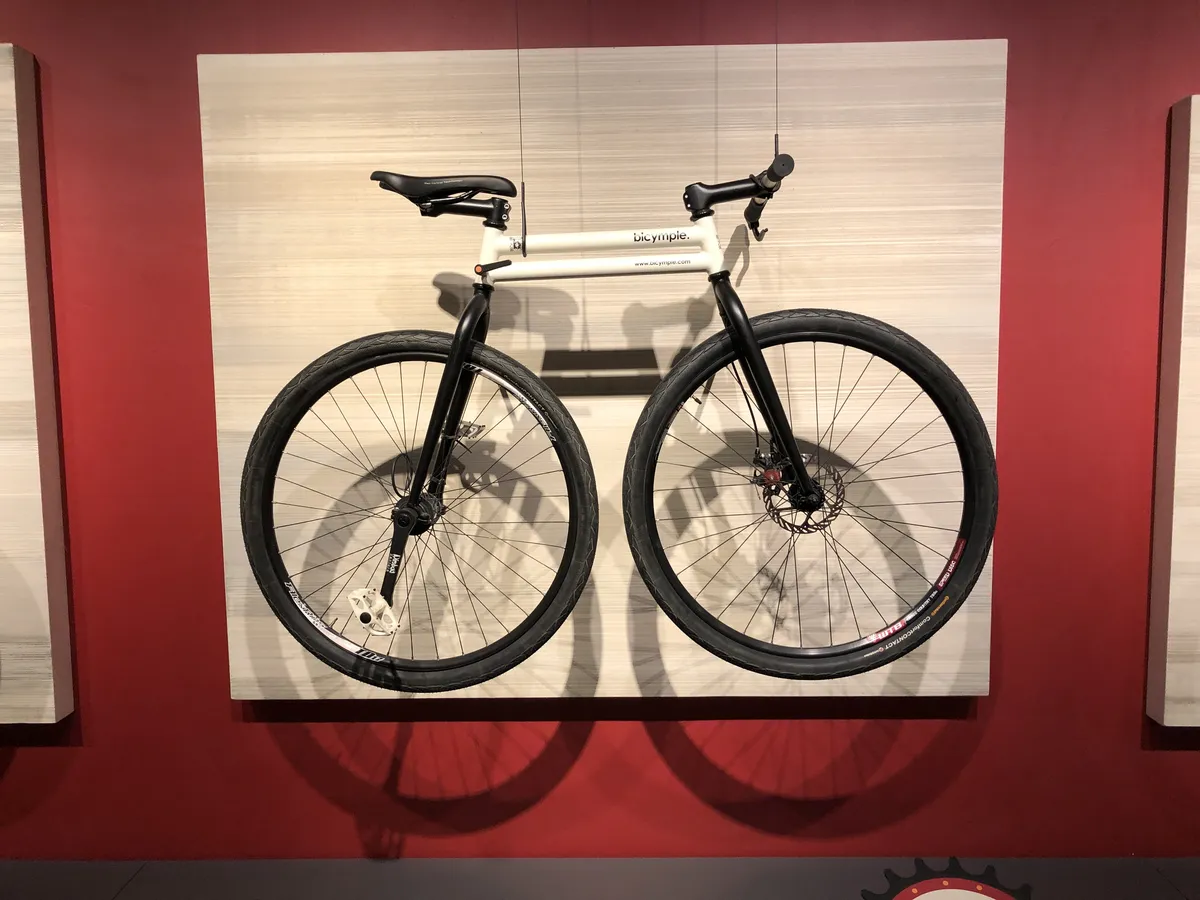
This is deranged. It is a literal clown bike. The guy running this company claimed for years that he was trying to innovate to "simplify" the bicycle, and the model he gave to the MSI has both his website URL and a QR code visible on the bike itself. Hustling hard as hell, clearly. But it's just a swing bike, and this exact type of swing bike is nothing new. When the bicymple appeared on the internet, reddit users were excited to point out that there is a lot of "prior art" in this area. Search "swing bike unicycle" to find this specific type of bike online.
The prior art was often specifically clown art. I want to make that clear.
The bicymple company still exists - their site is here. They claim to be seeking the most "simple" bike design in the world. But it also has disc brakes, which make it substantially more complex than other unicycle swing bikes. And riding it? Sure as fuck not simple. This type of bike exists for the sole purpose of performing tricks.
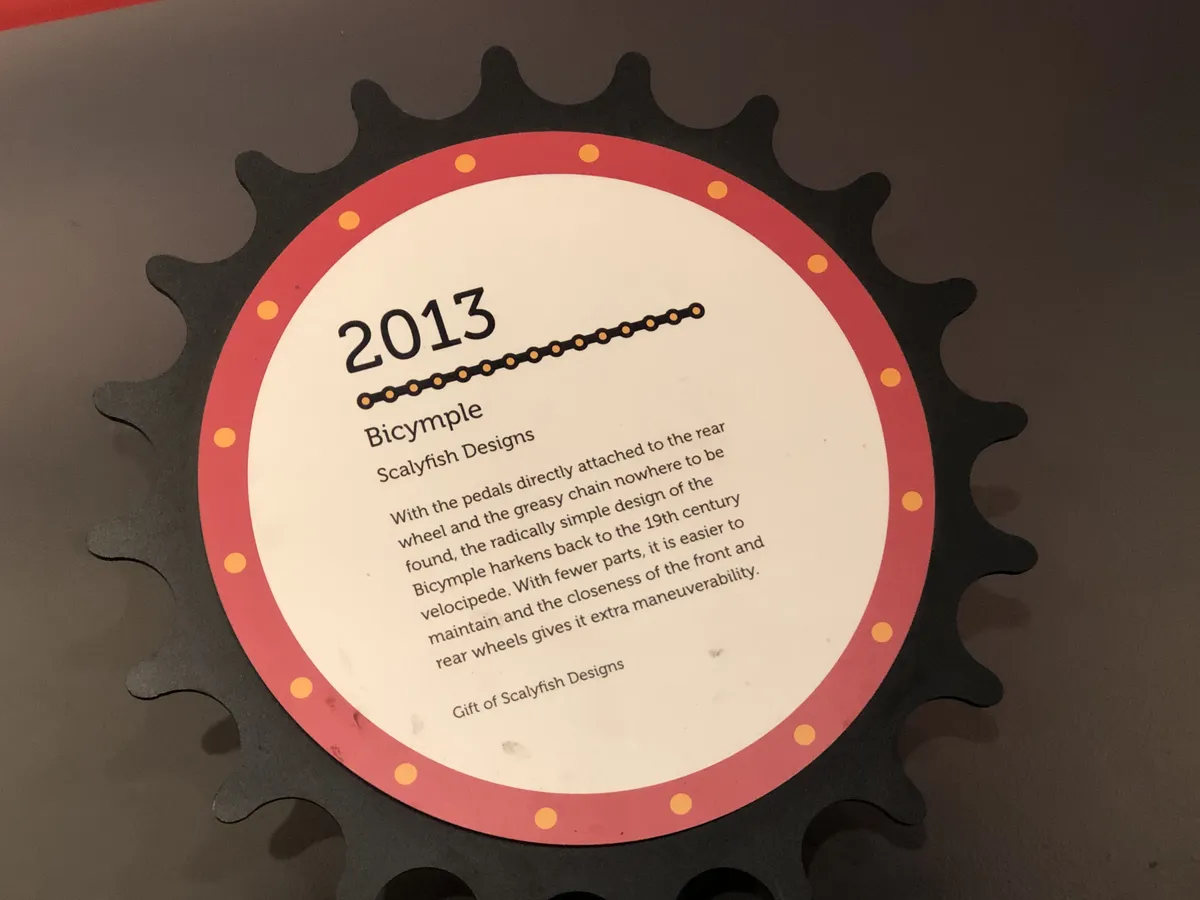
The fact that this bike was included in the MSI exhibit with essentially press release content is the best example of how poorly curated and researched the "modern" section of the exhibit is. Really shameful. It would have been incredible to have a real section of this exhibit about clown bikes, swing bikes, and unicycles. Instead, they got tricked by a fucking loser.
Cardboard Bicycle - 2013
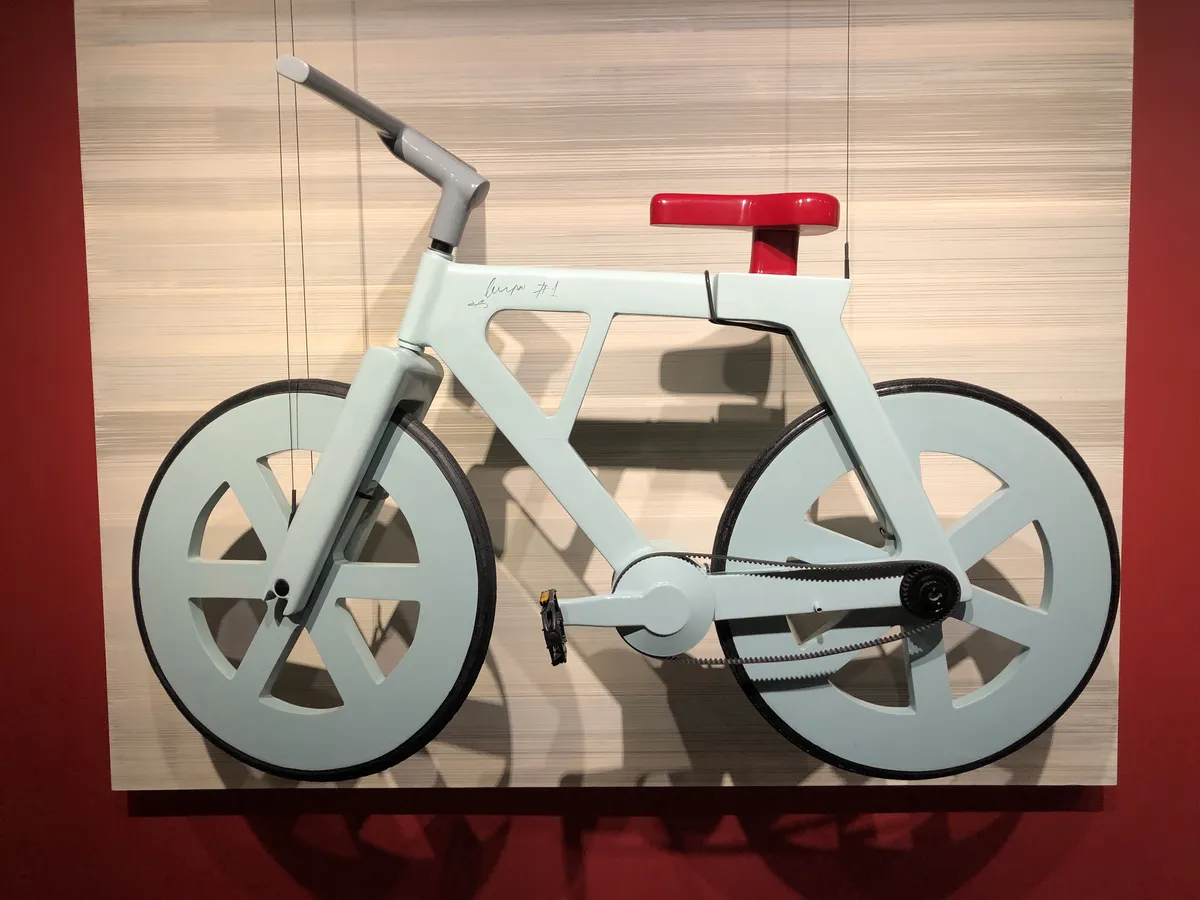
This is just more brain-dead "MSI partners with grifter startup guys" shit. I'm just gonna link you to Wikipedia here. The bike at the MSI is Izhar Gafni's prototype.
In 2012, Izhar Gafni, an Israeli mechanical engineer and cycling enthusiast, unveiled a prototype bicycle made almost entirely out of cardboard in his workshop in Moshav Ahituv. The components, including bike’s frame, wheels, handlebars and saddle, consist of sheets of cardboard folded and glued together. The complete bike weighs 20 pounds (9.1 kg), and is treated to be fireproof and waterproof. Gafni reports that it can support riders up to 220 kilograms (490 lb). It has solid rubber tires made from recycled car tires. Power is transferred from the pedals to the rear wheel with a belt, also made from recycled rubber. Gafni and a business partner planned to mass-produce a bike based on the prototype and retail it for 20 USD, with a unit cost of 9 to 12 USD. The target market is low-income countries. The prototype was featured at the November 2012 Microsoft ThinkNext event in Tel Aviv. Gafni has been trying to raise 2 million on Indiegogo to fund the project. As of 25 June 2013, he had raised 10 thousand. The campaign has ended with a total of 40,107 raised.
So, in 2012-2013, while this exhibit was being put together at the MSI, there was probably a news cycle about this dude's cardboard bike, and they took one of his fucking bikes and put it in the museum as an example of the future of bikes, and at the same time he was on Kickstarter trying to get 2 million dollars, and instead he got 40k, and the future of the cardboard bike was dead.
What I want to know is whether the Kickstarter failed before or after the museum exhibit launched.
When it comes to eco-friendly frame materials - there's been a lot of research into this area over the last 5 or so years, and currently the consensus is that ferrous steel is the most environmentally-friendly frame material. Steel bikes can be useful for decades - I regularly see people riding 30+ year old steel-frame bikes. They can be repaired, modified, and preserved much more easily than an aluminum bike, which is slightly less eco-friendly to manufacture and completely impractical to repair. There are companies out there making steel-framed utility bikes for the exact type of low-income people Gafni wanted to serve with his cardboard bike - but unlike cardboard, those steel bikes can carry a lot of weight. They use highly standardized parts instead of proprietary components like Gafni's recycled rubber belt. They can be repaired or modified by locals with welding skills. A family could use one of these bikes for a generation. I recently rebuilt my mother's steel bike from the early 1970s and gave it to a friend - generational bikes are not so rare. Almost all of them are made of steel, not glue.
Trek Madone 7 - 2013
A carbon bike. You can see it here - I don't know anything about carbon bikes, but those prices are probably pretty fake. The Madone is still a Trek product line. The MSI had a little statement about its aerodynamic tube shapes. Pretty regular science-and-industry stuff.
Cannondale Super6 EVO - 2013
The modern versions of this bike come in carbon models which sell for well over 10k. The MSI called this one "ballistic grade." Okay, dudes.
Boy, there are sure a lot of carbon road bikes in this exhibit. What do you think the chance was that they wrote to every manufacturer, got a bunch, and then put the most expensive one at the front of the exhibit?
Surly Moonlander - 2012

They put a fat bike in the exhibit! Hell yeah! I have nothing bad to say about Surly - they're still chugging along. And people still buy fat-tire bikes. This was another example of a rare historically-validated selection from the exhibit's survey of the industry.
I also linked the sparkly paint job.
Renovo R4 - 2013

A wooden bike!! The company still exists. Its bikes are custom orders. I am not sure they make the one in the MSI anymore.
Marc Willers' BMX Promax
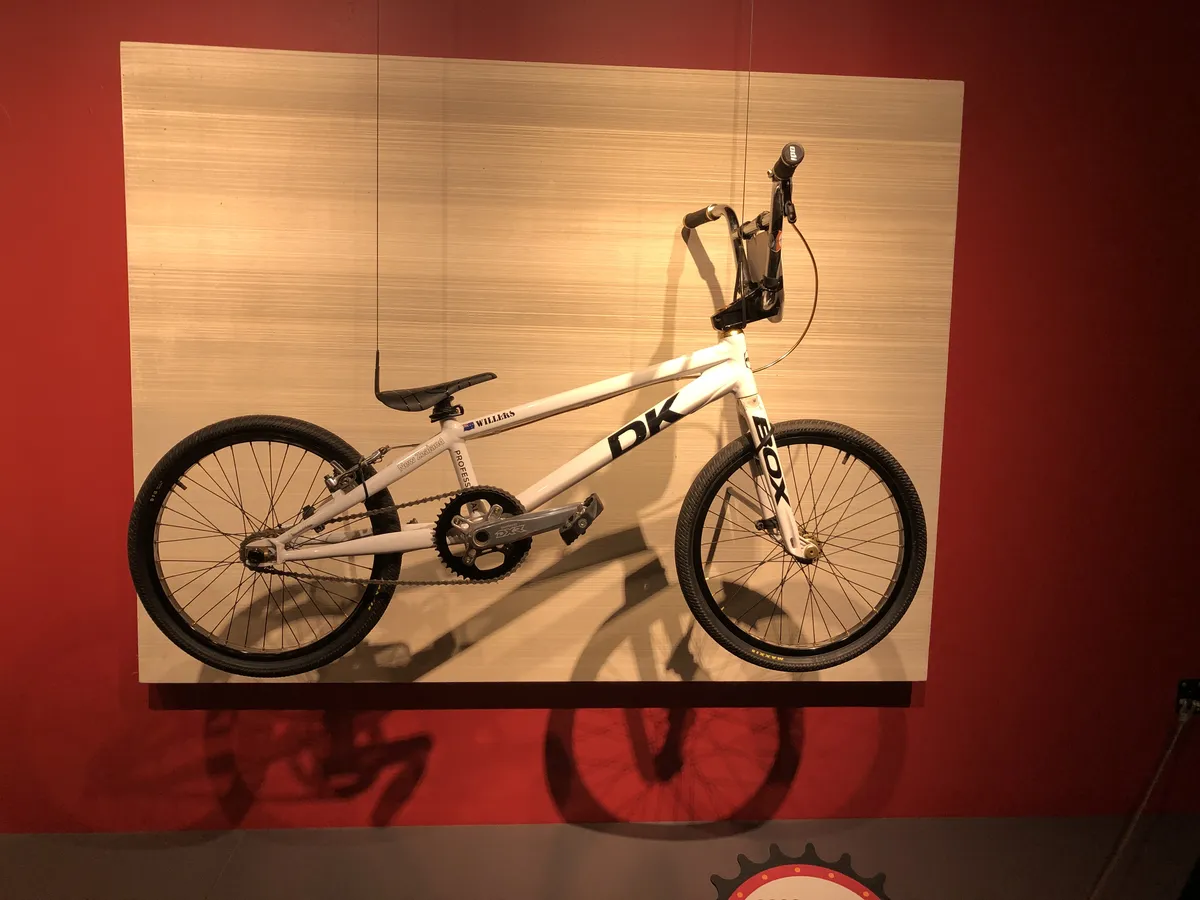
This is a BMX designed with input from an Olympian, Marc Willers, who rode it in the 2008 and 2012 Olympics. The description of the bike makes some reference to "simplifying" the components "to make them lightweight," and reducing flex in the frame... but it's not clear to me to what degree the choices made in the design of this bike were substantially different from the choices made in the design of any high-performance competition bicycle.
I was talking with some friends after visiting this and another disappointing museum in Chicago - the American Writers' Museum - and we were wondering: is every museum like this? When you REALLY understand the thing on display in a museum, how often does the pedagogy strike you as impossibly dumb?
I think the MSI in particular might be an impossibly dumb museum. But I hope that I haven't been thoughtlessly experiencing this same degree of idiocy at every museum I've ever visited.
God, the clown bike. I cannot stop thinking about it. The fucking clown bike!!!!!!!!!!